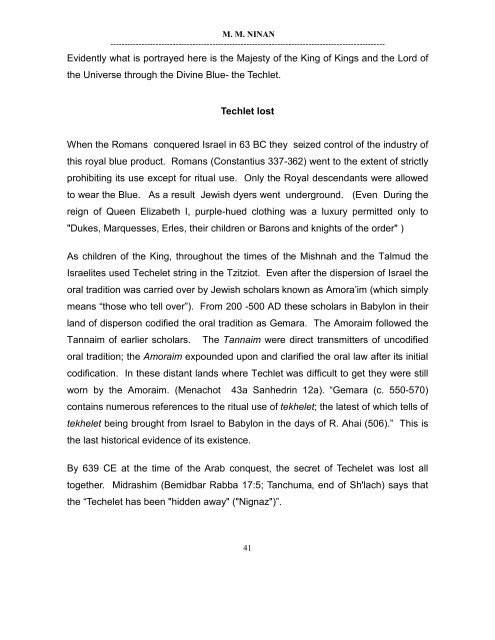Create successful ePaper yourself
Turn your PDF publications into a flip-book with our unique Google optimized e-Paper software.
M. M. NINAN<br />
-------------------------------------------------------------------------------------------------<br />
Evidently what is portrayed here is <strong>the</strong> Majesty <strong>of</strong> <strong>the</strong> King <strong>of</strong> Kings <strong>and</strong> <strong>the</strong> Lord <strong>of</strong><br />
<strong>the</strong> Universe through <strong>the</strong> Divine Blue- <strong>the</strong> Techlet.<br />
Techlet lost<br />
When <strong>the</strong> Romans conquered Israel in 63 BC <strong>the</strong>y seized control <strong>of</strong> <strong>the</strong> industry <strong>of</strong><br />
this royal blue product. Romans (Constantius 337-362) went to <strong>the</strong> extent <strong>of</strong> strictly<br />
prohibiting its use except for ritual use. Only <strong>the</strong> Royal descendants were allowed<br />
to wear <strong>the</strong> Blue. As a result Jewish dyers went underground. (Even During <strong>the</strong><br />
reign <strong>of</strong> Queen Elizabeth I, purple-hued clothing was a luxury permitted only to<br />
"Dukes, Marquesses, Erles, <strong>the</strong>ir children or Barons <strong>and</strong> knights <strong>of</strong> <strong>the</strong> order" )<br />
As children <strong>of</strong> <strong>the</strong> King, throughout <strong>the</strong> times <strong>of</strong> <strong>the</strong> Mishnah <strong>and</strong> <strong>the</strong> Talmud <strong>the</strong><br />
Israelites used Techelet string in <strong>the</strong> Tzitziot. Even after <strong>the</strong> dispersion <strong>of</strong> Israel <strong>the</strong><br />
oral tradition was carried over by Jewish scholars known as Amora’im (which simply<br />
means “those who tell over”). From 200 -500 AD <strong>the</strong>se scholars in Babylon in <strong>the</strong>ir<br />
l<strong>and</strong> <strong>of</strong> disperson codified <strong>the</strong> oral tradition as Gemara. The Amoraim followed <strong>the</strong><br />
Tannaim <strong>of</strong> earlier scholars. The Tannaim were direct transmitters <strong>of</strong> uncodified<br />
oral tradition; <strong>the</strong> Amoraim expounded upon <strong>and</strong> clarified <strong>the</strong> oral law after its initial<br />
codification. In <strong>the</strong>se distant l<strong>and</strong>s where Techlet was difficult to get <strong>the</strong>y were still<br />
worn by <strong>the</strong> Amoraim. (Menachot 43a Sanhedrin 12a). “Gemara (c. 550-570)<br />
contains numerous references to <strong>the</strong> ritual use <strong>of</strong> tekhelet; <strong>the</strong> latest <strong>of</strong> which tells <strong>of</strong><br />
tekhelet being brought from Israel to Babylon in <strong>the</strong> days <strong>of</strong> R. Ahai (506).” This is<br />
<strong>the</strong> last historical evidence <strong>of</strong> its existence.<br />
By 639 CE at <strong>the</strong> time <strong>of</strong> <strong>the</strong> Arab conquest, <strong>the</strong> secret <strong>of</strong> Techelet was lost all<br />
toge<strong>the</strong>r. Midrashim (Bemidbar Rabba 17:5; Tanchuma, end <strong>of</strong> Sh'lach) says that<br />
<strong>the</strong> “Techelet has been "hidden away" ("Nignaz")”.<br />
41


















